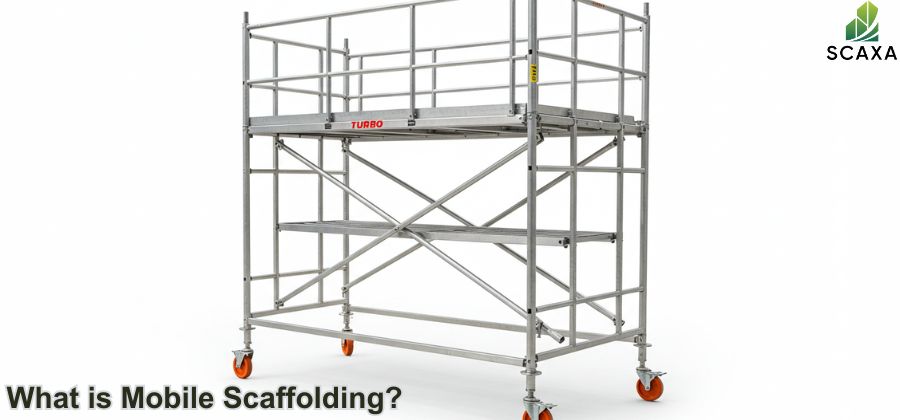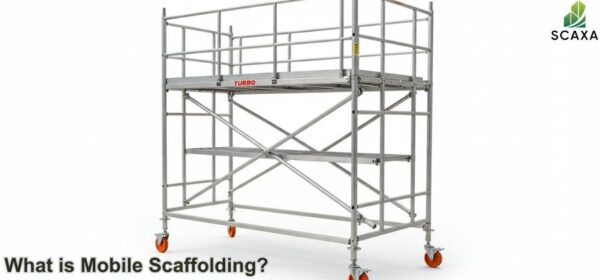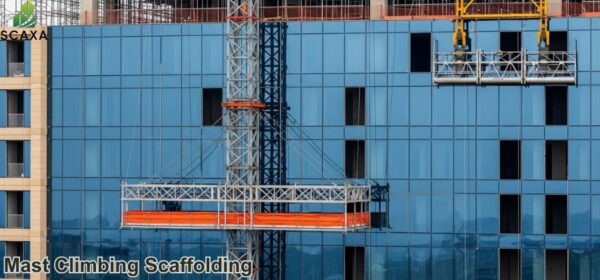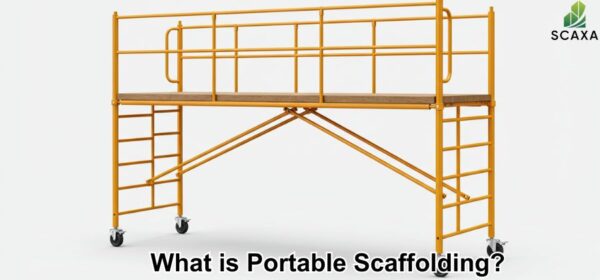A mobile scaffold is a temporary structure mounted on wheels or casters designed for easy movement and repositioning. It is a mobile tower that is supported by caster wheels. Workers can move it all across the work site easily. It is an ideal temporary structure for tasks requiring frequent position changes. The main types of mobile scaffolds are foldable, single-width, double-width, and heavy-duty. Flexibility, mobility, easy assembly, durability, and safety features are the main benefits of a mobile scaffold. Typical uses of mobile scaffolding include building construction and maintenance, painting and decoration, window cleaning, and event production. A mobile scaffold comprises structural, access, safety, base, and mobility components.
What is Mobile scaffolding?
A mobile scaffolding is a portable tower with wheels that makes it easy for workers to move towers from one place to another easily. Instead of doing multiple times assembly and dismantling, workers can set up this tower once and then roll it around through wheels. Its ease of mobility and quick setup makes it an ideal scaffolding to use for regular maintenance and repair projects in a construction. A mobile scaffold is an effective temporary structure to utilize for asks requiring frequent repositioning and quick turnaround such as DIY home tasks, painting and HVAC upkeep.
What are the Benefits of Mobile Scaffolding?
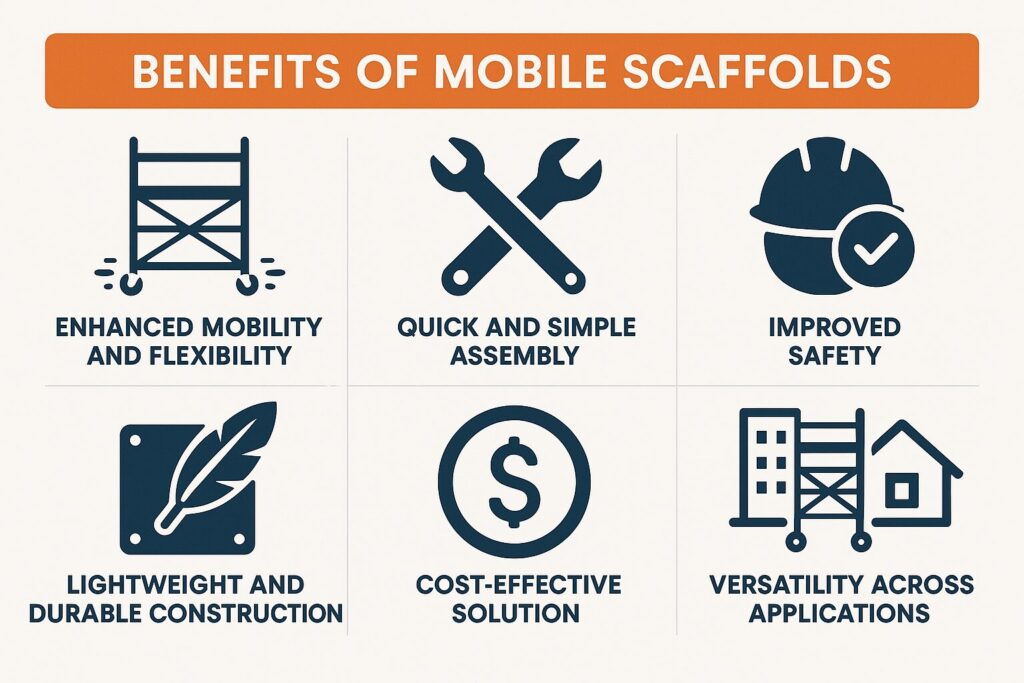
The six benefits of mobile scaffolds are as follows:
- Enhanced Mobility and Flexibility
- Quick and Simple Assembly
- Improved Safety
- Lightweight and Durable Construction
- Cost-Effective Solution
- Versatility Across Applications
Enhanced Mobility and Flexibility
A mobile scaffold is designed with wheels that let workers move the whole structure from one place to another without assembling or dismantling it again and again. They need to roll it all across the job site and perform their tasks. Workers can save their time and energy because no frequent assembly is required. This enhanced mobility and flexibility make this mobile scaffold useful for frequent repositioning tasks.
Quick and simple assembly
Scaffold towers are super easy to assemble and don’t require any specialist training for setup. Every mobile scaffold has the manufacturer’s instructions that you need to follow to put together all the components. Many mobile scaffolds have modular designs that let you easily set up the whole structure. Workers can add a level to this scaffold depending on the project requirements.
Lightweight and durable
Mobile scaffolds are lightweight aluminum and don’t have heavy galvanized steel poles. It’s easy for workers to transport them from one place to another. Aluminum non-ferrous metal is non-corrosive or resistant to rust. As a result, aluminum-made towers are highly durable. They can withstand extreme weather conditions at various construction sites. These sturdy towers offer a structurally sound platform supporting workers’ and materials’ weight and strain. Investment in this access tower provides high ROI for contractors, who can use it for a long operational lifespan. Mobile scaffolds are safe to use for many years when they are well-maintained.
Improved Safety
Safety rails are used to protect workers on these temporary structures. Safety rails are installed both in front and above the working platform. Guardrails work as an exterior barrier, protecting the working area and preventing workers from falling off accidentally. Workers can do their routine tasks in a spacious area supported by their legs. They can complete complex tasks on this stable surface and have peace of mind that the structure won’t lose its balance. A mobile scaffold is designed with an anti-slip platform and a secure locking mechanism. Workers don’t slip and trip from the platform as they have a solid space to use. Secure locking mechanisms lock the wheels and ensure the structure doesn’t sway or collapse while workers use the platform.
Versatile Across applications
Mobile scaffolds are helpful in various jobs, from building construction to machine inspection, regular repair, and maintenance. In the construction industry, workers rely on mobile scaffolding to complete roofing and brickwork tasks. In the event industry, crews install cameras, speakers, and other devices using mobile scaffolds. They are super effective access towers for jobs that require frequent repositioning, such as plastering, decoration, and window cleaning.
Cost-effective solution
Mobile scaffolding is a cost-effective solution compared to other types of scaffolding, which require extensive resources such as manpower and tools to build a temporary structure. A mobile tower is simple to make and only requires a few components and a workforce. Contractors spend less on their setup and can use this tower for various industry applications.
What are the disadvantages of Mobile Scaffolding?
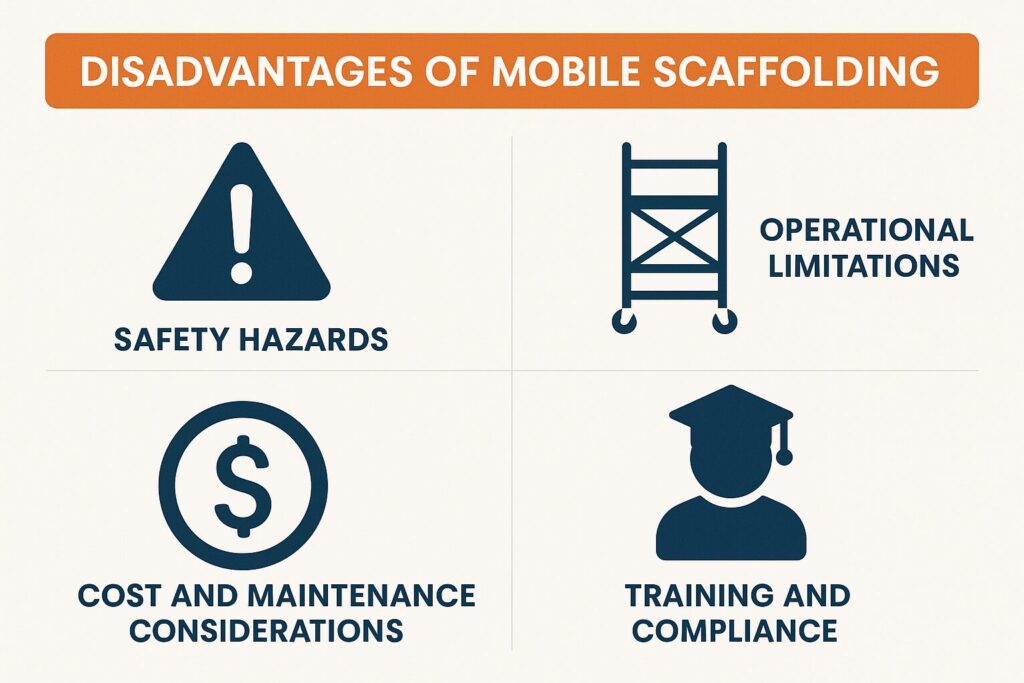
The four disadvantages of mobile scaffolding are as follows:
1. Safety Hazards
A mobile scaffold is associated with various safety hazards. Workers can fall from the platform, the whole structure may tip over due to overloading, and a slight movement puts every worker at risk. Safety hazards of mobile scaffolds are described as follows:
- Risk of Falls and Tip-Overs
Every mobile scaffold is at risk of tipping over when the weight of material and people exceeds the normal limit. Workers may also fall from the platform, especially when safety guardrails are not installed.
- Unintentional Movement
Workers need to lock the wheels while working on the platform because an unintentional and sudden movement may lead to the accidental fall of workers and materials. Workers are prohibited from sliding the scaffold while materials or workers are still on the platform because any sudden movement disturbs the balance of the structure and puts everyone in jeopardy.
- Exposure to Environmental Factors
A mobile scaffold is a useful access tower for indoor tasks. When placed outdoors, environmental factors impact its stability. For example, heavy rain or snow makes the platform slippery and unsuitable. Heavy wind is an extreme lateral force against which the tower can’t stand, or may collapse or tip over.
2. Operational Limitations
A mobile scaffold is useful for carrying out lightweight tasks since it’s made of lightweight aluminum. It shouldn’t be used for heavy-duty tasks.
- Limited Load Capacity
The load capacity of aluminum mobile scaffolds is lower than that of fixed and steel-made towers. Manufacturers always mention load limits that every worker needs to adhere to to prevent accidental falls and tip-overs.
- Terrain Restrictions
Mobile scaffolds work well on flat surfaces. However, they are at risk of accidents or structural collapse on uneven or rough terrain.
- Height Limitations
Mobile towers have height limitations; it’s not possible to access skyscrapers through them. They are suitable for jobs with low—to medium-scale heights only.
3. Cost and Maintenance Considerations
Mobile scaffolding is a costly investment. The contractor spends money on its purchase and also later on to keep this temporary structure operational. Cost and maintenance considerations for mobile scaffolds are as follows:
- Higher Initial Investment
The cost of a mobile scaffold is high compared to a ladder. Contractors need to pay more for this tower due to its durability, portability, and lightweight nature.
- Storage Requirements
Mobile scaffolds have modular components that should be kept in the same place. Any mishandling during storage damages the components and requires contractors to spend money on replacement parts.
4. Training and Compliance
A mobile scaffold user must have proper training to use, assemble, and dismantle this temporary structure. Whoever uses this scaffold on a site must comply with the regulations. Training and compliance related to mobile scaffolding are as follows:
- Need for Proper Training
Every employee who uses a mobile scaffold must undergo proper training. Although its setup is pretty simple, workers must know how to put together its parts and what not to do while using it.
- Regulatory Compliance
Mobile scaffolds have specific safety guidelines that users need to follow to avoid legal complications and fines. These regulatory guidelines include the following height and load limits, erection and dismantling of the scaffold only by a competent person, use of fall protection and safety measures, regular inspection of the mobile scaffold before, during, and after use, and proper training of every worker.
What are the uses of Mobile Scaffolding?
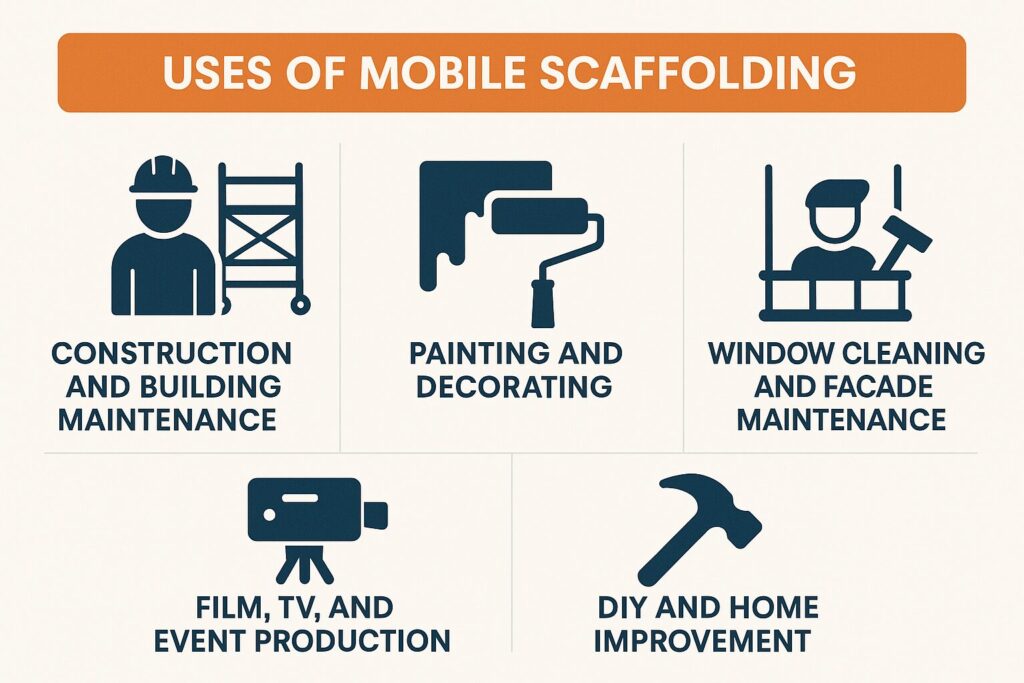
The five uses of mobile scaffolding are as follows:
- Construction and Building Maintenance
- Painting and Decorating
- Window Cleaning and Facade Maintenance
- Film, TV, and Event Production
- DIY and Home Improvement
- Construction and Building Maintenance
Mobile scaffolding offers masonry workers a stable working space during building construction. Workers can access a certain height and carry out their routine tasks. An aluminum mobile tower is commonly used to access different areas of the bridge during bridge maintenance tasks. Maintenance teams at airport terminals rely on mobile scaffolding to access high ceilings and light fixtures. Mobile scaffolds are also used for road work and streetlight repair so that high-traffic areas can progress safely.
2. Painting and decorating
Mobile scaffolds allow workers to perform tasks such as painting and decorating at industrial and commercial levels with utmost speed and accuracy. This temporary access platform lets workers paint high-rise buildings and commercial structures with ease. Workers can also effortlessly access difficult-to-reach areas and decorate outdoor spaces through a mobile tower.
3. Window Cleaning and Facade Maintenance
Workers get a stable work area from a mobile scaffold when cleaning tall windows or glass walls in a multi-story building or residential spaces. They can clean tall and wide windows without feeling fatigued. Mobile scaffolds ares commonly used for facade maintenance when workers need to handle tasks such as cleaning, painting, sealing, or repairing building exteriors. This temporary structure comes with height adjustability, letting workers adjust height as per task requirements.
4. Film, TV, and Event Production
Mobile scaffolding is an ideal temporary access solution during film, TV, and event production. In the UAE, many large-scale events are hosted by companies, such as trade shows, religious events, corporate festivals, and more. During these productions, crews rely on mobile scaffolding to install light and sound equipment and stage setup.
5. DIY and Home Improvement
Mobile scaffolding is used for many DIY and home improvement tasks. It offers a broad platform where a DIYer can keep tools, paint, and supplies while painting walls and ceilings. It is safer than a ladder when installing or replacing electrical fixtures at varied ceiling heights. This temporary structure offers easy access to hard-to-reach areas for hanging curtains, drapes, or blinds. It makes cleaning of gutters and roof edges simple for every homeowner. A mobile scaffold reduces fatigue by offering an ergonomic position while a DIYer is handling the task of ceiling repair or finishing drywall sheets.
What are the Parts of Mobile Scaffolding?
The four parts of mobile scaffolding are as follows:
1. Structural Components
The structural components of mobile scaffolds are as follows:
End Frame
The frame of the mobile scaffold is designed with two rows of multiple rung tubes in between. A single-width frame is somewhere between 0.75 and 0.90 metres wide. A double-width frame is 1.35 meters wide and provides room for two platforms. Once the basic frame of the mobile scaffold is formed, the next step is to add two-meter frames, if required. The mobile scaffold’s collar tube is at the upright top and has a cone shape so that the next frame gets connected and fits smoothly. Another name for a collar tube is a tube coupler. A locking pin or latching bolt is used to secure frames stacked on top of one another.
Platforms (Decks)
The platforms of a mobile scaffold serve as a working floor. The tower’s top platform is used for working, while the other platforms can be used for intermediate landings. The platform is adjusted to a scaffold by placing the hooks on the rungs of the frame. Once the platform is set correctly, workers can climb up through the inside of the frame and get access. Two platforms are placed at the desired working height in a double-width mobile scaffold, and one requires a hatch. It is secured from both sides to protect the platform against wind and lateral forces.
Horizontal and Diagonal Braces
Horizontal and diagonal braces are used to secure the overall framework of a mobile scaffold, as they are bonding elements of a structure. Horizontal braces are placed on both sides of the introductory section under the vertical upright first rung. These braces are on the inside so the frames do not bend. The diagonal braces are placed on one another like a cross. A brace has claws on both sides with a spring and pawl to quickly connect to a rung or upright. Diagonal braces are longer than horizontal braces and are used to support the overall structure of the mobile scaffold. Horizontal braces are installed at the base of the scaffold. Commonly, two horizontal braces are used for the base. The number of horizontal braces for each level is four. These braces are also placed in a way that acts as a guard to protect the platform from all sides. Four diagonal braces are used for every two meters up the tower.
2. Safety Features
The safety features of mobile scaffolds include:
Guardrails
Guardrails are safety rails installed on the edges of platforms to prevent accidental falls. Every scaffold must have a guardrail at the hip level to reduce the risk of falling. At the highest platform of scaffolds, guardrail systems are combined with braces to ensure maximum safety.
Toe boards
A toeboard must be installed on the working floor or platform of a mobile scaffold. A toeboard is a safety rail raised on the edges of the platform so that equipment and material don’t fall down. Wooden toeboards are secured in toe board holders from all corners of the platform. Boards are installed in the same dimension as the platform. The size range of a toeboard is from 506 to 3200 mm, while the weight ranges from 0.72 to 6.20 kg.
Outriggers (Stabilizers)
Outriggers/stabilizers are horizontal extensions extending from the base of a mobile scaffold to increase its footprint and improve stability. They prevent tipping of the structure when the height exceeds its base-to-height ratio. The purpose of stabilizers is to provide lateral support at great height and uneven surfaces. Stabilizers support the overall scaffold structure and prevent it from tipping over. Two stabilizers are used to build a scaffold that works against the wall to keep it stable. The length of the stabilizer is from 2.3 to 10 meters. The length of the stabilizer is based on the height of the mobile scaffolding platforms.
3. Base and Mobility Components
The base and mobility components of mobile scaffolds are as follows:
Base Plates
Base plates are flat metal plates placed at the bottom of the scaffold legs. They are used to improve the stability of the structure by distributing weight evenly. Scaffold legs don’t sink into soft surfaces like soil and sand in the presence of base plates. They offer a secure and level contact point of the overall scaffold with the ground or floor.
Casters (Wheels)
A mobile scaffold has wheel legs where wheels fit securely. A wheel leg comprises a circlip, a swivel, and a spindle. It also has a double brake pedal. The spindle lets workers adjust the height of the mobile tower and level the tower on uneven ground. The wheels attached to swivel legs ensure that the scaffold can be moved around effortlessly. They make repositioning from one place to another simple and quick.Castor wheels are adjustable up to 400mm and super flexible for uneven surfaces.
4. Access and Additional Components
The access and additional components of the mobility scaffold are as follows:
Ladders or Ladder Frames
Ladders are stairways installed on a mobile scaffold. They are designed with hooks on one end where ladders are attached to the ladder frame. These hooks ensure that the ladder doesn’t slip and stays in its fixed place.
Couplers and Clamps
Couplers are specialized fittings used to connect two scaffold tubes at different angles. They are used to connect horizontal, vertical, and diagonal tubes. Clamps are fastening mechanisms or adjustable grips. They secure components like braces, ladders, and guardrails in a mobile scaffold. Couplers and clamps provide additional strength at the joints and prevent movement and vibration of the structure under lateral forces. A mobile scaffold uses couplers and clamps for custom extensions or configuration.
Tags (Inspection Tags)
Inspection tags are color-coded labels or tags attached to scaffolds. They demonstrate that the structure has been inspected and indicate its safety status. Green inspection tags showcase that the scaffold is safe and ready for use. Yellow tags show that scaffolding needs caution and has restricted use. A red tag is a warning tag that demonstrates that the scaffold is unsafe and no one should use it. Every inspection tag includes notes, the next due inspection date, the date of inspection, and the inspector’s name.
What are Types of Mobile Scaffold?
The seven types of mobile scaffold are as follows:
- Folding Mobile Scaffolds
- Single-Width Mobile Scaffolds
- Double-Width Mobile Scaffolds
- Heavy-Duty Mobile Scaffolds
- Aluminium Mobile Scaffolds
- H-Frame Mobile Scaffolds
- Prefabricated Mobile Scaffold Towers
1. Single-Width Scaffold
A single-width scaffold is designed with a single-width platform supported by four wheels. This compact temporary structure is easy to move around in tight spaces. It is commonly used in small spaces for indoor construction, especially for tasks that require frequent mobility.
2. Double-Width Mobile Scaffold
A Double-width mobile scaffold is designed with a double-width platform. It offers more space for workers, tools, and equipment than single-width mobile scaffolds, making it suitable for projects that require more workspace.
3. Folding Mobile Scaffold
Folding mobile scaffolds are easy to fold and unfold. They are built with hinges and folding mechanisms that let the whole structure collapse into compact sizes. This mobile scaffold is useful for limited space and frequent transportation tasks.
4. Heavy-Duty Mobile Scaffolds
Heavy-duty mobile scaffolds are designed to carry heavy loads, such as heavy tools and materials. They are robust temporary mobile towers that can handle demanding tasks and sustain more weight than their lightweight counterparts.
5. Aluminum Mobile Scaffolds
Aluminum mobile scaffolds are made from lightweight aluminum metal. They are easy to move around and suitable for only lightweight tasks.
6. H-frame Mobile scaffold
An H-frame mobile scaffold is built with two vertical posts connected through a horizontal crosspiece. The horizontal and vertical components are combined to form an “H” shape. It offers a stable working platform for workers handling tasks at height. Many H-frame mobile scaffolds are heavy-duty. They are useful for tasks where maximum coverage is required.
7. Prefabricated mobile scaffold towers
Prefabricated mobile scaffold towers are an integrated system of prefabricated components built with pre-determined geometry. These modular components are easy to put together.
What are the Safety Requirements of Mobile Scaffolding?
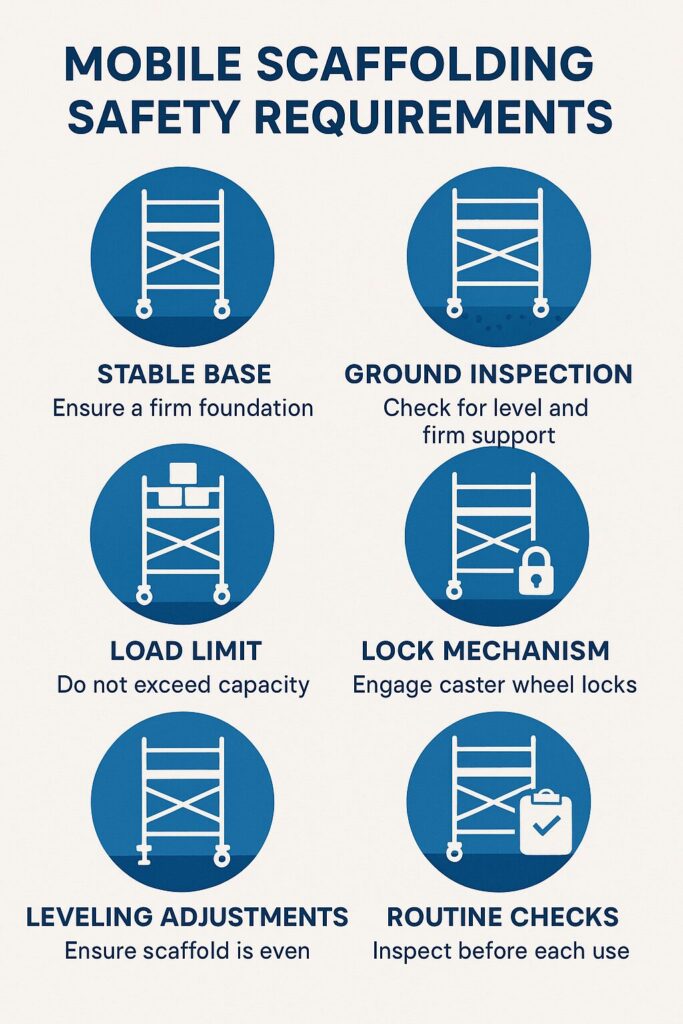
The six safety requirement of mobile scaffolding are as follows:
- Set up scaffold on a stable base
- Inspect the ground to maintain the proper level
- Follow maximum load limit
- Turn on the secure locking mechanism during use
- Adjust leveling component properly
- Conduct routine inspections
1. Set up a Scaffold on a Stable base.
A stable base is the first safety requirement of a mobile scaffold. A mobile tower needs a stable base to provide a safe and secure working area. Using this scaffold on unstable ground or uneven surfaces imbalances it and increases the risk of structural collapse and tip-over. Scaffolding should always be placed on a firm and level base.
2. Inspect the ground to maintain the proper level.
Before setting up a mobile tower, it is important to inspect the ground space for irregularities such as loose soil, debris, slopes, and holes. Clearing away all obstacles is the best way to prevent instability or tipping hazards. When the ground is not properly level, it’s important to use leveling equipment such as adjustable legs or base plates to provide stable footing for the overall structure.
3. Follow Maximum Load Limit
The manufacturer defines the weight limit of a mobile scaffold. It is important to stick with the limit, and the weight must be adequately distributed throughout the framework. Be careful about the weight of tools, equipment, and workers on the scaffold. Crossing the maximum allowed load limit puts everyone at risk and often leads to collapse.
4. Turn on the Secure Locking Mechanism during use
It is essential that wheels are locked and secured in their position while workers are doing their tasks. Secure locking of the wheel is important to prevent unintended shifting or movement that may cause an accidental fall or tip-over.
5. Adjust Leveling Components Properly.
Constantly adjust the leveling components of the mobile scaffold properly. Ensure all four sides have equal support to protect the overall frame from rocking motion or tilting.
6. Conduct Routine Inspections
The safety of mobile scaffolds remains intact when inspectors inspect their components and levels regularly. Routine inspection ensures that mobile scaffolds have proper solid base levels and don’t have damaged components. When any issue is detected during inspection, it should be addressed promptly to prevent safety hazards.
What are the OSHA Guidelines for Mobile Scaffolding?
The six OSHA guidelines for mobile scaffolding are as follows:
- Mobile scaffolds shall have horizontal, diagonal, cross, and combination braces to prevent the structure from collapsing, secure vertical members of components together, and automatically square and align the vertical members. All brace connections shall be secure, and the scaffold shall be level, square, and plumb.
- Scaffold casters or wheels must be locked to prevent movement, mainly when the scaffold is stationary.
- Manual force is applied to move the scaffold as close to the base as possible, and it should not be more than 5 feet above the supporting surface.
- The power system used to propel a mobile scaffold shall be designed for this specific use. A mobile scaffold should not be driven with motor vehicles, trucks, or forklifts unless a mobile tower is designed to use such propulsion systems.
- Scaffolds shall be stabilized to prevent tipping during movement.
- The employee is prohibited from riding on a mobile scaffold unless the following conditions exist:
- The surface on which the scaffold has to be moved is within 3 degrees of level and doesn’t have pits, holes, or obstructions.
- The height to base width ratio of scaffolding during its movement is two to one or less unless constructed to meet or exceed nationally recognized stability test requirements.
- Outrigger frames must be installed on both sides of the scaffold whenever used.
- When a power system is used to propel a scaffold, then the propelling force applied to the wheel should produce a speed of more than 1 foot per second (.3 mps); and
- No employee is present on any scaffold part that extends outward beyond casters, wheels, or other supports.
- The platform shall not go beyond the base support unless outriggers are used to improve stability.
- Screw jacks or similar components are used for leveling the scaffold as and when required.
- Caster stems and wheel stems shall be secured in scaffold legs or adjustment screws.
- Before a scaffold is actually moved, each employee on a mobile scaffold should be made aware of the move.
How much is the rental for mobile scaffolding?
The rental cost of a mobile aluminum scaffolding tower is AED 50 to 150 per day, depending on the tower’s height, while the cost of frame scaffolding is around AED 100 to 300 per day. The rental cost of a custom modular system is usually high; it is somewhere between AED 200 and 250 per day.
Can you use a Mobile ladder on a scaffold?
No, you can not use a mobile ladder on a scaffold, as it is not a safe practice. Ladders are designed to be used on solid ground instead of a temporary structure like a scaffold.
What is the Maximum Height of a Mobile Scaffold?
The maximum height of the mobile scaffold platform is 12 meters inside a building and 8 meters outside a building.



